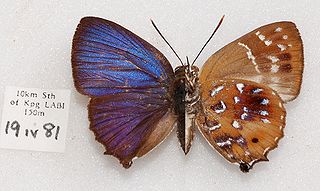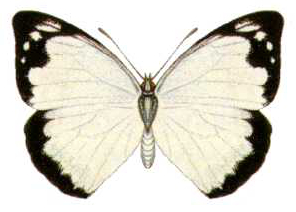
Gandaca harina, the tree yellow, is a butterfly in the family Pieridae. It is found in India, Thailand, Cambodia, Myanmar, Malaysia, Singapore, Philippines, and Indonesia. The species was first described by Thomas Horsfield in 1829.

Logania distanti, the dark mottle, is a small but striking butterfly found in India that belongs to the lycaenids or blues. It was first described by Georg Semper in 1889.

William Lucas Distant was an English entomologist.

Iraota distanti, the Distant's silverstreak, is a species of lycaenid or blue butterfly with at least two subspecies found in Peninsular Thailand, Malaya, Singapore, Sumatra, Mentawi and Borneo.

Pirdana is a genus of grass skippers in the family Hesperiidae.

Saletara liberia is a butterfly of the family Pieridae. It is found in Indonesia, the Philippines, Peninsular Malaysia and various islands in the region. Subspecies S. l. distanti is known by the common name Malaysian albatross.

Appias paulina, the common albatross, Christmas Island white or Ceylon lesser albatross, is a butterfly of the family Pieridae. It is found from India to Samoa, including Indonesia, Japan, Malaysia, New Caledonia, Sri Lanka, Thailand and Australia.
Leptotyphlops distanti, also known as Distant's threadsnake or Distant's worm snake, is a species of snake in the family Leptotyphlopidae. The species, Leptotyphlops distanti, is endemic to Southern Africa.

Ideopsis gaura, the smaller wood nymph, is a species of nymphalid butterfly in the Danainae subfamily. It is found in Southeast Asia.

Cyclosia is a genus of zygaenid moth that has a mimicry complex with the milkweed butterfly.

The Cyclosia Midamia is a moth, also called a mimic moth, out of the nominate species of the burnet moth. It is extremely fascinating, considering its defense mechanism. It disguises itself to look like a butterfly called the spotted blue crow. It looks and acts just like this butterfly. It secretes a liquid called hydrogen cyanide that can be extremely poisonous and sometimes deadly. This can seriously harm humans. They excrete this out of their legs as little droplets. Though unlike the butterfly, and so many other insects, the Cyclosia Midamia produces its own poison made out of the chemical compound Cyanide. If a human ingests or touches enough Cyadine they could become seriously injured, and even die. So though these moths are pretty on the outside they aren’t on the inside. So don't touch.
Cyclosia panthona is a moth in the family Zygaenidae. It was described by Caspar Stoll in 1780. It is found in China, Hong Kong, India, Sri Lanka, and Myanmar.

Cyclosia papilionaris, Drury's jewel, is a moth in the family Zygaenidae. It was described by Dru Drury in 1773. It is found from Thailand to southern China. It is also found in Andaman and Nicobar Islands, India. The habitat consists of rainforests and humid deciduous forests at altitudes up to 1,000 meters.
Cyclosia pieridoides, the False Idea Moth, is a moth in the family Zygaenidae. It was described by Francis Walker in 1862. It is found in Asia.

Idmon distanti is a butterfly in the family Hesperiidae. It was described by Shepard in 1937. It is found in southern Burma, Thailand, Langkawi, Malaysia, Singapore, Borneo, Sipora, Siberut, Batoe, Sumatra and Nias.

Eublaberus distanti, known as the six-spotted, four-spotted, four-spot, or Trinidad bat-cave roach or cockroach, is a primarily cave-dwelling Central and South American cockroach of the genus Eublaberus.

Eublaberus is a genus of cockroaches closely related to Blaberus. Among the differences are proportionately somewhat shorter, stouter limbs, a broad blackish bar on the caudal margin (rear) of the pronotum, and angulation on the lateral margins (sides) of the pronotum.
Caulotops distanti is a species of plant bug in the family Miridae. It is found in Central America, North America, and South America.
Clidophleps distanti is a species of cicada in the family Cicadidae. It is found in Central America and North America.
Proba distanti is a species of plant bug in the family Miridae. It is found in Central America and North America.











